Abstract
Radioimmunometric and enzyme-immunometric assays were developed for the detection of salmonellae in pure and mixed cultures as well as in 59 food samples. The performances of titanous hydroxide suspension and microtiter plates as the solid phase for the immobilization of microorganisms were compared in these immunoassays. Detection of populations of salmonella cells in pure culture, diluted with saline, was 4- to 10-fold more sensitive with the microtiter plates. However, with mixed culture of salmonella and other enterobacterial species, the detection sensitivity with titanous hydroxide was 100- to 160-fold more sensitive than with microtiter plates. Good correlation existed between results of a standard cultural method for the detection of salmonellae in foods and those obtained from radioimmunometric and enzyme-immunometric assays utilizing titanous hydroxide. However, a high incidence of false-positive and false-negative results with food samples occurred with the enzyme-immunometric assay utilizing microtiter plates. The results provided strong evidence for the merits of substituting titanous hydroxide for microtiter plates as the solid phase for the immobilization of salmonellae for their detection by immunoassays. The immunoassays were rapid and enabled the analysis of a large number of selective enrichment cultures of food samples for salmonellae within 8 h.
Full text
PDF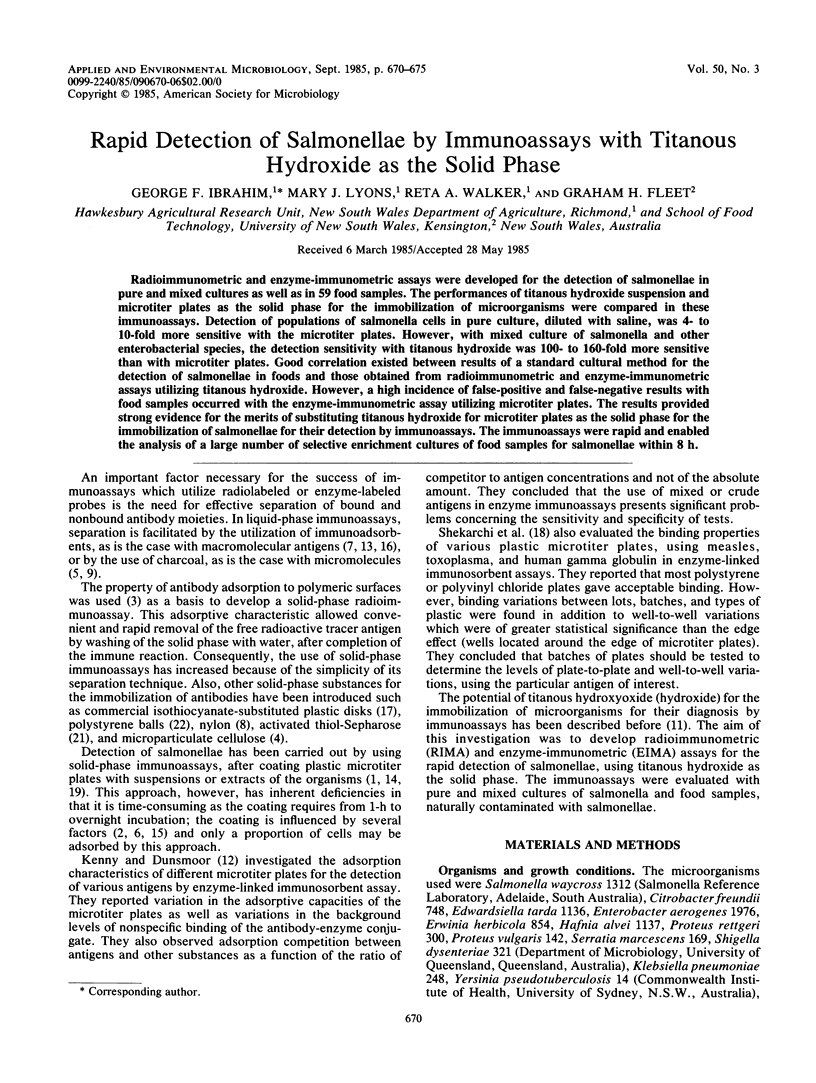
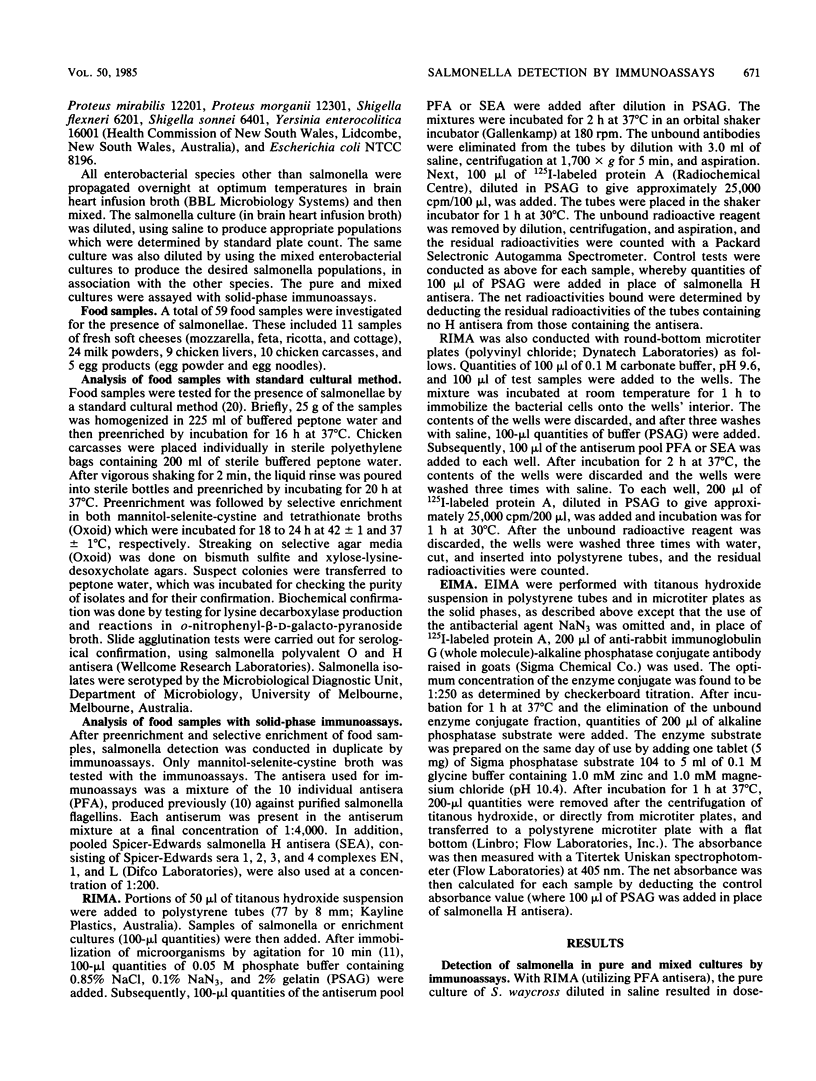
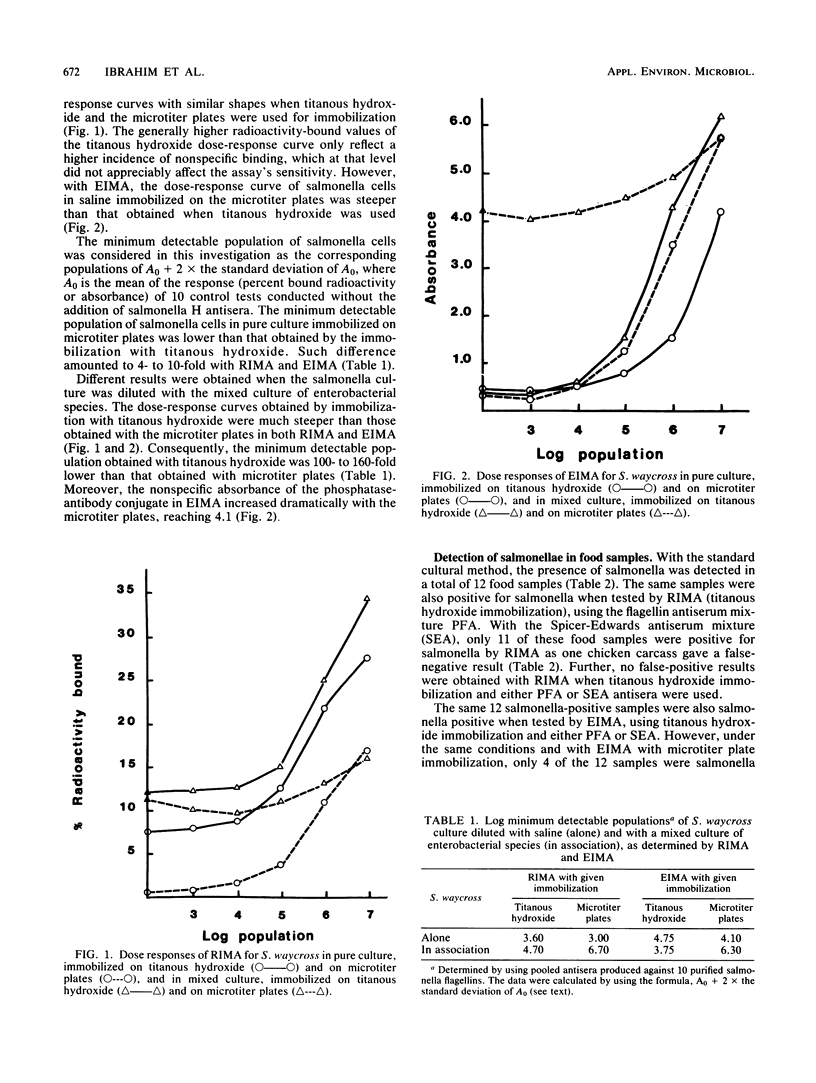

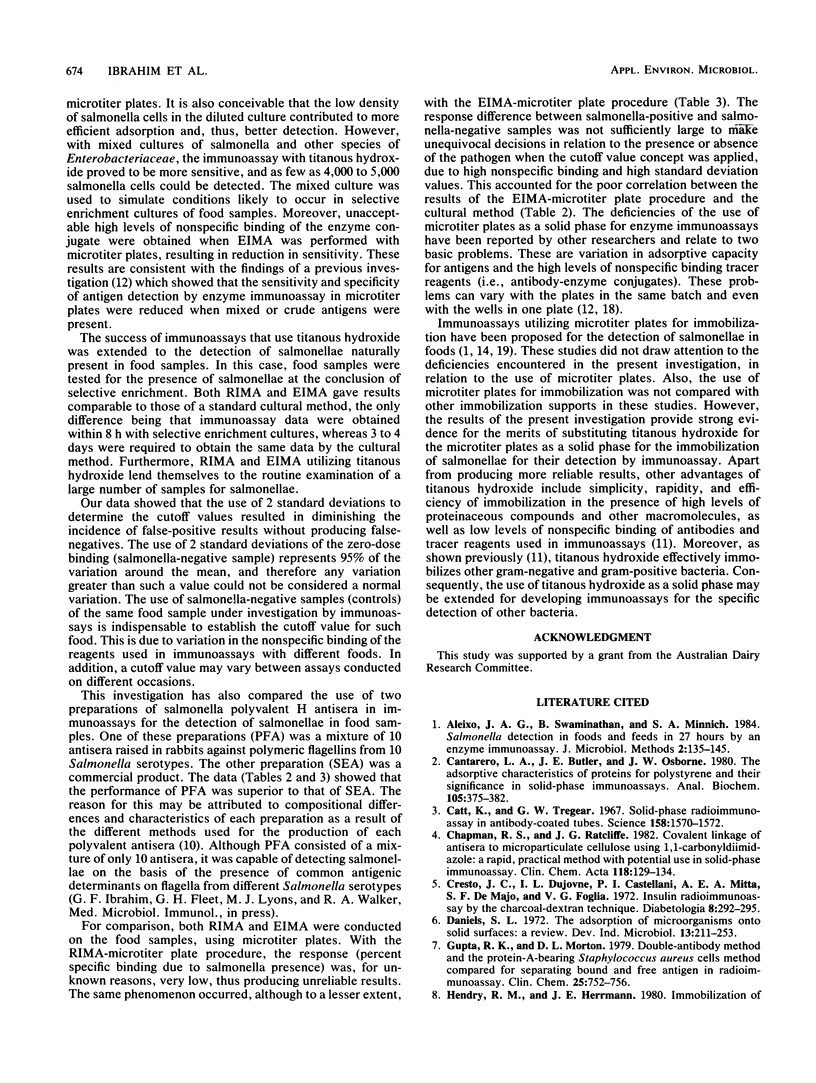
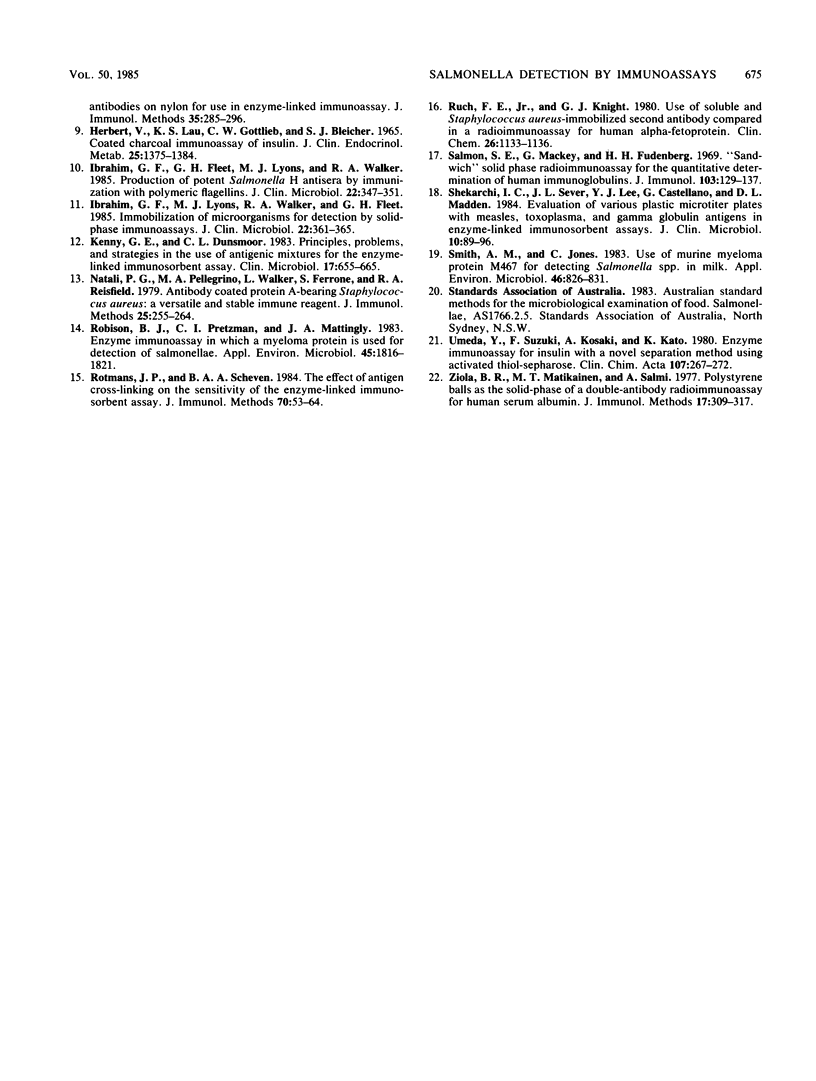
Selected References
These references are in PubMed. This may not be the complete list of references from this article.
- Cantarero L. A., Butler J. E., Osborne J. W. The adsorptive characteristics of proteins for polystyrene and their significance in solid-phase imunoassays. Anal Biochem. 1980 Jul 1;105(2):375–382. doi: 10.1016/0003-2697(80)90473-x. [DOI] [PubMed] [Google Scholar]
- Catt K., Tregear G. W. Solid-phase radioimmunoassay in antibody-coated tubes. Science. 1967 Dec 22;158(3808):1570–1572. doi: 10.1126/science.158.3808.1570. [DOI] [PubMed] [Google Scholar]
- Chapman R. S., Ratcliffe J. G. Covalent linkage of antisera to microparticulate cellulose using 1,1'-carbonyldiimidazole: a rapid, practical method with potential use in solid-phase immunoassay. Clin Chim Acta. 1982 Jan 5;118(1):129–134. doi: 10.1016/0009-8981(82)90235-2. [DOI] [PubMed] [Google Scholar]
- Cresto J. C., Dujovne I. L., Castellani P. I., Mitta E. A., De Majo S. F., Foglia V. G. Insulin radioimmunoassay by the charcoal-dextran technique. Diabetologia. 1972 Aug;8(4):292–295. doi: 10.1007/BF01225574. [DOI] [PubMed] [Google Scholar]
- Gupta R. K., Morton D. L. Double-antibody method and the protein-A-bearing Staphylococcus aureus cells method compared for separating bound and free antigen in radioimmunoassay. Clin Chem. 1979 May;25(5):752–756. [PubMed] [Google Scholar]
- Herbert V., Lau K. S., Gottlieb C. W., Bleicher S. J. Coated charcoal immunoassay of insulin. J Clin Endocrinol Metab. 1965 Oct;25(10):1375–1384. doi: 10.1210/jcem-25-10-1375. [DOI] [PubMed] [Google Scholar]
- Ibrahim G. F., Fleet G. H., Lyons M. J., Walker R. A. Production of potent Salmonella H antisera by immunization with polymeric flagellins. J Clin Microbiol. 1985 Sep;22(3):347–351. doi: 10.1128/jcm.22.3.347-351.1985. [DOI] [PMC free article] [PubMed] [Google Scholar]
- Ibrahim G. F., Lyons M. J., Walker R. A., Fleet G. H. Immobilization of microorganisms for detection by solid-phase immunoassays. J Clin Microbiol. 1985 Sep;22(3):361–365. doi: 10.1128/jcm.22.3.361-365.1985. [DOI] [PMC free article] [PubMed] [Google Scholar]
- Kenny G. E., Dunsmoor C. L. Principles, problems, and strategies in the use of antigenic mixtures for the enzyme-linked immunosorbent assay. J Clin Microbiol. 1983 Apr;17(4):655–665. doi: 10.1128/jcm.17.4.655-665.1983. [DOI] [PMC free article] [PubMed] [Google Scholar]
- Natali P. G., Pellegrino M. A., Walker L., Ferrone S., Reisfeld R. A. Antibody-coated protein A-bearing Staphylococcus aureus: a versatile and stable immune reagent. J Immunol Methods. 1979;25(3):255–264. doi: 10.1016/0022-1759(79)90113-3. [DOI] [PubMed] [Google Scholar]
- Robison B. J., Pretzman C. I., Mattingly J. A. Enzyme immunoassay in which a myeloma protein is used for detection of salmonellae. Appl Environ Microbiol. 1983 Jun;45(6):1816–1821. doi: 10.1128/aem.45.6.1816-1821.1983. [DOI] [PMC free article] [PubMed] [Google Scholar]
- Rotmans J. P., Scheven B. A. The effect of antigen cross-linking on the sensitivity of the enzyme-linked immunosorbent assay. J Immunol Methods. 1984 May 11;70(1):53–64. doi: 10.1016/0022-1759(84)90389-2. [DOI] [PubMed] [Google Scholar]
- Ruch F. E., Jr, Knight G. J. Use of soluble and Staphylococcus aureus-immobilized second antibody compared in a radioimmunoassay for human alpha-fetoprotein. Clin Chem. 1980 Jul;26(8):1133–1166. [PubMed] [Google Scholar]
- Salmon S. E., Mackey G., Fudenberg H. H. "Sandwich" solid phase radioimmunoassay for the quantitative deterimination of human immunoglobulins. J Immunol. 1969 Jul;103(1):129–137. [PubMed] [Google Scholar]
- Shekarchi I. C., Sever J. L., Lee Y. J., Castellano G., Madden D. L. Evaluation of various plastic microtiter plates with measles, toxoplasma, and gamma globulin antigens in enzyme-linked immunosorbent assays. J Clin Microbiol. 1984 Feb;19(2):89–96. doi: 10.1128/jcm.19.2.89-96.1984. [DOI] [PMC free article] [PubMed] [Google Scholar]
- Smith A. M., Jones C. Use of murine myeloma protein M467 for detecting Salmonella spp. in milk. Appl Environ Microbiol. 1983 Oct;46(4):826–831. doi: 10.1128/aem.46.4.826-831.1983. [DOI] [PMC free article] [PubMed] [Google Scholar]
- Umeda Y., Suzuki F., Kosaka A., Kato K. Enzyme immunoassay for insulin with a novel separation method using activated thiol-Sepharose. Clin Chim Acta. 1980 Nov 6;107(3):267–272. doi: 10.1016/0009-8981(80)90455-6. [DOI] [PubMed] [Google Scholar]
- Ziola B. R., Matikainen M. T., Salmi A. Polystyrene balls as the solid-phase of a double-antibody radioimmunoassay for human serum albumin. J Immunol Methods. 1977;17(3-4):309–317. doi: 10.1016/0022-1759(77)90113-2. [DOI] [PubMed] [Google Scholar]


